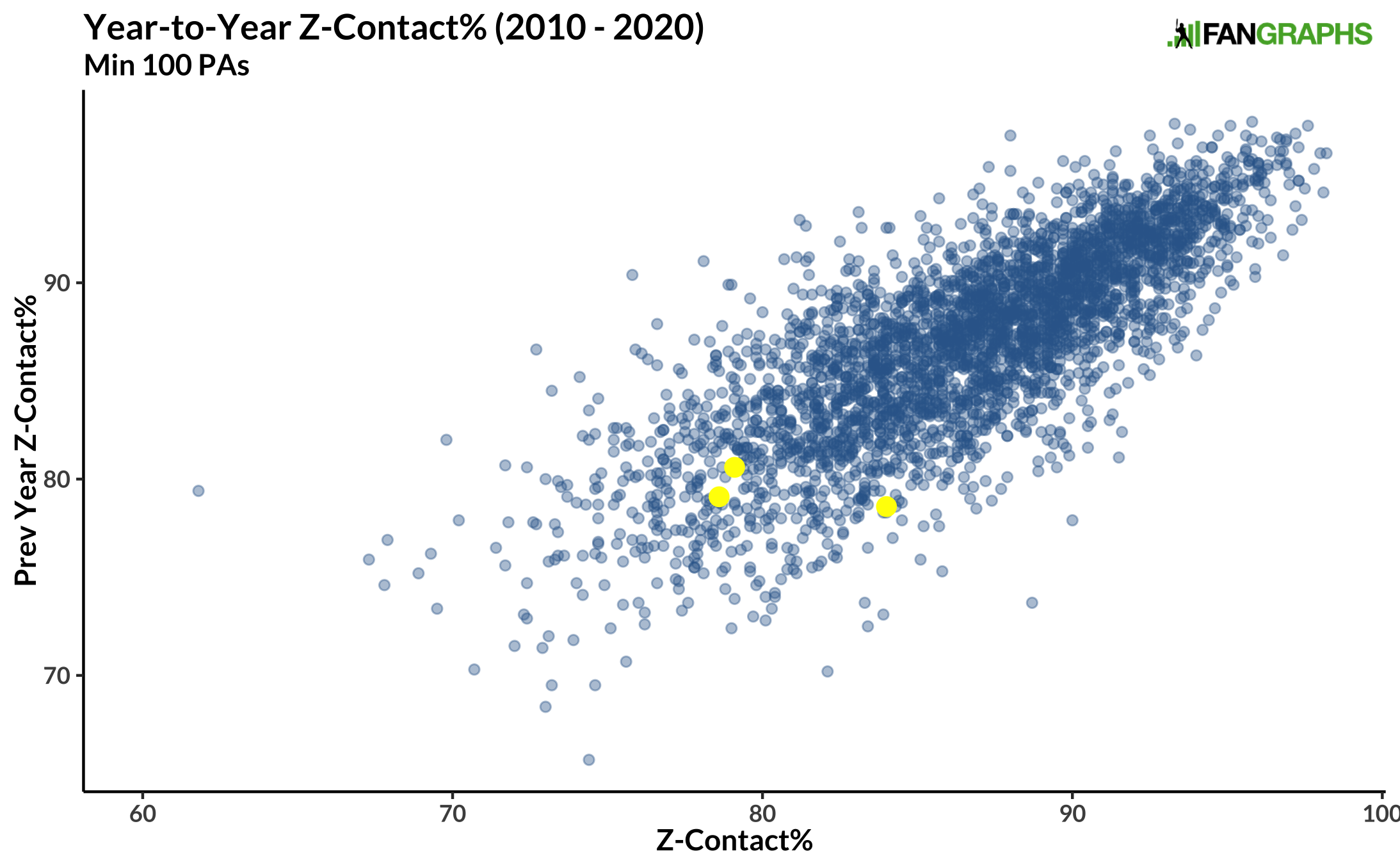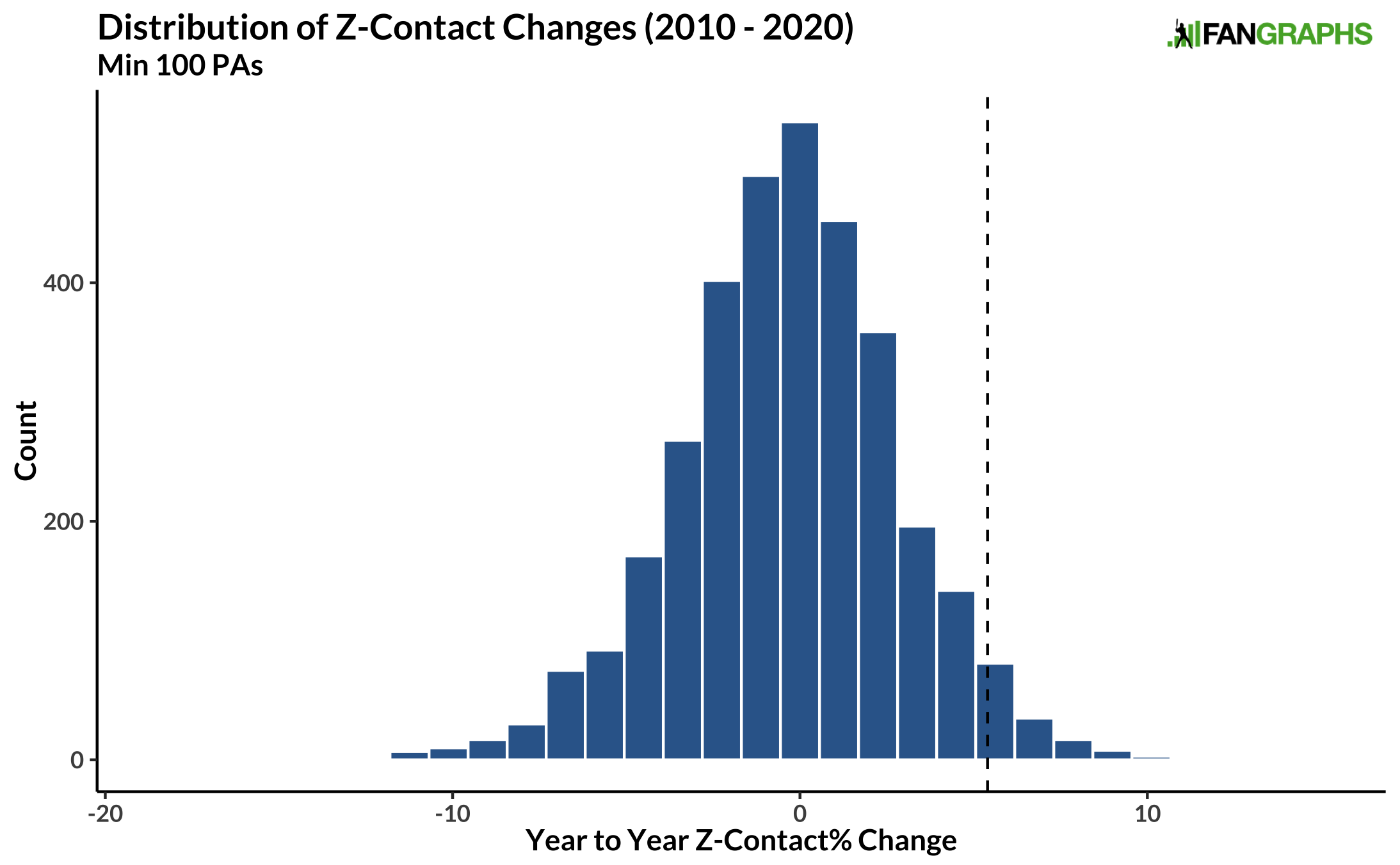Aaron Judge Might Have Already Taken the Next Step
This is Owen’s first piece as a FanGraphs contributor. Owen is a recent college graduate who is passionate about all things baseball, data, and baseball data. As a native of Northern California, he has been a firsthand witness to historic baseball events such as Sean Doolittle, hitting prospect; Aaron Judge, football player; and Cliff Pennington. Among other things, he hopes to provide insight into machine learning and advanced analytics.
Aaron Judge has always been a fascinating case study; anyone with such an extreme profile helps to build our understanding of both what is possible and what is relevant to our understanding of which players are good. We know that even in the face of a high strikeout rate and below-average contact rates, Judge is an elite player, due in no small part to his 99th percentile power; he owns a career wRC+ of 151 despite having a 31% strikeout rate. But for many, there is a nagging sense of “what if.” What kind of hitter could he be if his plate discipline were better?
Those “what ifs” are the result of the improvement we saw Judge make after a 2017 swing change. We’re now years removed from that campaign. Judge’s 1,000-plus plate appearances since then make it likely that his plate discipline skills are what they are at this point. He was a model of consistency from 2017-19: an O-Swing% in the range of 24.6% to 25.9%, a Swing% that ranged from 40.3% to 42.7%, a CSW% that ranged from 28.6% to 31.5%, and a Contact% that ranged from 65.1% to 67.6%. Our coarse understanding of hitters’ plate discipline skills is that they’re largely immutable. After all, if they were more malleable, we’d probably see a lot more players cut their strikeout rates and boost their walk rates. Sometimes a change in how much a hitter is swinging outside the zone will stick out, but it’s often accompanied by a shift in how much they’re swinging overall, suggesting a change in their approach rather than a leap forward in their underlying ball and strike recognition.
Joey Gallo’s 2019 stands out as a prime example. It’s easy to point to his 8% drop in O-Swing% and think he was a different guy, but when that drop is accompanied by an 8% drop in his swings overall and the same CSW%, you get the sense that we’re observing a change in his approach rather than some shift in his underlying skillset. Gallo’s adjustments are a bit like moving around plugs in a leaky dam, fixing one issue while creating another. To find true changes in ball/strike recognition, you almost want to see consistency in what I’ll call the approach stats while also seeing a change in a ball/strike recognition stat.
Let’s return to Judge. Early in the season, I tend to keep an eye on plate discipline numbers because they become meaningful pretty quickly. Scrolling through the 2021 leaderboards, Judge’s SwStr% is around 9%. That stands out because it’s in the single digits, while his career average is much higher than that. I was curious as to when this started, and what it might mean. If we track Judge’s career stats, everything appears to be the same approach-wise year-to-year until there’s a spike in his Z-Contact% in 2020 that doesn’t have a corresponding Z-Swing% change. This has continued into 2021, and might be the nexus of a performance jump this season and beyond.
Before we get ahead of ourselves, let’s take a look at the distribution of Z-Contact% for all batter seasons.

Prior to 2020, Judge’s career Z-Contact% stood at 79.6%. He posted an 84% Z-Contact% in the shortened season. While that came in just 114 PAs, we know that’s long enough to generally stabilize. It’s also important to understand the relationship between Z-Contact% year-to-year.

There’s a very strong relationship overall, with a correlation of 0.79. Judge is highlighted here to illustrate how far out he sits compared to the rest of the league and how stable his contact rates were from 2017-19. I keep talking about a jump in Z-Contact%, but you need context for how large this is.

Judge’s 5.4% jump from 2019 to ’20 is marked by the dotted line and represents one of the bigger changes over that period. Of course, there’s more room for a player with a lower Z-Contact% to make large gains, but even still, this gain is substantial.
I’m sure you want to know how often these jumps stick for good. There have only been 114 player seasons with as large or greater a year-to-year jump in Z-Contact%. On average, those players saw a -2.67% change in their Z-Contact% in the seasons after their jumps. If Judge were to hold a 3% gain, it could have a significant affect on how pitchers approach him.
While some of these gains could disappear, it’s important for us to remember the player we’re talking about. Judge has standout power and a strike zone unlike almost anyone else’s. For Judge specifically, an increase in Z-Contact% would mean overcoming low pitches in some way. Tall guy (and former big leaguer turned FanGraphs resident) Nate Freiman found that taller batters tend to have more called strikes below the zone than shorter ones. The flip side is that shorter hitters have more called strikes at their relative top of the zone compared to taller hitters, but that isn’t much of an equivalence as regardless of size, batters probably don’t have to worry about pitchers attacking them with offspeed pitches up in the zone.
On Baseball Savant we can take a quick glance at the designated “Shadow” portion of the bottom of the zone where pitches are meant to have roughly a 50% chance of being called a ball or strike. Of the 233 batters who have seen at least 500 takes in that zone in the Statcast Era, Judge’s called strike rate stands as the tenth highest at 54.4%. These spots are meant to be 50/50 calls but only 21 of those 233 had called strike rates 50% or higher. There’s an endless amount of theorizing as to why this happens to Judge but regardless, it happens and will probably keep happening.
Judge himself has expressed frustrations with his strike zone. The low pitch is the source of many called strikes for him and he’s often felt the need to cover it up. No player wants to stop improving and for Judge the biggest improvement to be made is cutting down his strikeouts. Hitters want to be able to cover the entire zone, but there comes a point where you’re better off taking pitches, especially if pitchers are targeting an edge that’s a weakness for you by batted ball quality or whiffs or both. It appears Judge might be catching on more and more.
His swings in the zone by year:

The contour plots only deal with pitches in the zone. I’ve marked the tops and bottoms of Judge’s average strike zone. Over time, his swings have been concentrated on pitches in the lower outside corner of the zone, but in 2020, he let those go a little more often. From 2019 to ’20 especially you can see the flip, with him swinging at more pitches towards the middle of the zone and not at his knees.
I’d show you what kind of contact Judge makes on these swings but the extreme nature of his exit velocities makes everything look good. However, if Judge is looking to consistently produce damage on batted balls, he has to swing at more of the middle-up pitches, as he does not have a swing particularly built for much loft with an attack angle below 10 degrees as found by Carmen Ciardiello.
I’m better off showing you swings where he can’t or doesn’t dole out punishment: grounders and whiffs.

The best way to get Judge to hit the ball on the ground or to miss on a pitch in the zone is by putting pitches where… he’s been swinging? It’s on pitches generally low and there isn’t enough data in 2021 to say anything definitive, but the overlap between his 2019 swings and whiffs/grounders suggest that Judge has been keen to trying to cover this hole in his swing. 2020 saw a change where he started to give up on those low and away pitches more often because they’ve largely done nothing good for him. The long-written about calls at the bottom of the zone have continued, so why let it detract from the overall skillset?
What I’ve been chasing as a skills change was really an approach change. A change in approach can be a nice makeover, and even for someone like Judge with elite production, giving up on trying to cover the entire zone can constitute a step forward.
In 2021, Judge has carried over his Z-Contact% gains to an 83.1% Z-Contact% to date. He’s still holding the SwStr% down to 9.9% but an O-Contact% of 64.4% appears unsustainable, especially considering his career best for any one season is 44.8%. We’re not quite at the level of PAs for these stats to be reliable, however we’re getting close enough that the gains from 2020 are looking real.
When I started looking into the Z-Contact% gainers, I knew it wouldn’t make much sense to comp Judge to very many other players; he’s an unusual player. For those with semi-comparable power, though, there is one player who might classify as having undergone a skills change. George Springer made these Z-Contact% jumps twice and is probably the poster child for a player who learned to control his strikeout rate. Springer’s first Z-Contact% jump from 2015 to ’16 (73% to 79%) didn’t even bring a one percent change in strikeout rate, but the second one from ’16 to ’17 (79% to 85%) saw him dropping from a 23.9% K% to a 17.6% K%. There is no guarantee of fewer strikeouts based on a Z-Contact% jump alone and no guarantee that Judge is taking the leap forward that Springer did. I brought up Springer in this case because there weren’t other Z-Contact% gainers that were already established stars by the time they made their jumps. The baseline approach change of Judge taking fewer swings on pitches that generate ground balls is a tantalizing proposition and a cut in K% would be icing on the cake to an already elite offensive player.
Controlling his strikeouts to the degree Springer has is probably something that Judge will never be able to do because of how much of the zone he has to cover. He probably doesn’t have the skill to cover all that he wants in the zone either, but this newfound ability to adjust his approach and let go of what doesn’t work for him might be as valuable as any skills change.
Owen is a contributor at FanGraphs. He got his start blogging about baseball when he was in college and you can find him maybe talking about something on Twitter @O_dotco.
Length, words, statistics, graphics… all the markings of a great first article, Owen!